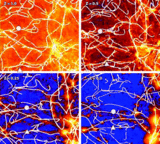Our Peculiar Motion Away from the Local Void
Abstract
The peculiar velocity of the Local Group of galaxies manifested in the cosmic microwave background dipole is found to decompose into three dominant components. The three components are clearly separated because they arise on distinct spatial scales and are fortuitously almost orthogonal in their influences. The nearest, which is distinguished by a velocity discontinuity at ~7 Mpc, arises from the evacuation of the Local Void. We lie in the Local Sheet that bounds the void. Random motions within the Local Sheet are small, and we advocate a reference frame with respect to the Local Sheet in preference to the Local Group. Our Galaxy participates in the bulk motion of the Local Sheet away from the Local Void. The component of our motion on an intermediate scale is attributed to the Virgo Cluster and its surroundings, 17 Mpc away. The third and largest component is an attraction on scales larger than 3000 km s-1 and centered near the direction of the Centaurus Cluster. The amplitudes of the three components are 259, 185, and 455 km s-1, respectively, adding collectively to 631 km s-1 in the reference frame of the Local Sheet. Taking the nearby influences into account, particularly that of the Local Void, causes the residual attributed to large scales to align with observed concentrations of distant galaxies and reduces somewhat the amplitude of motion attributed to their pull. Concerning the motion of ~260 km s-1 away from the Local Void, given the velocities expected from gravitational instability theory in the standard cosmological paradigm, the distance to the center of the Local Void must be at least 23 Mpc from our position. The Local Void is extremely large.
- Publication:
-
The Astrophysical Journal
- Pub Date:
- March 2008
- DOI:
- 10.1086/527428
- arXiv:
- arXiv:0705.4139
- Bibcode:
- 2008ApJ...676..184T
- Keywords:
-
- dark matter;
- galaxies: distances and redshifts;
- large-scale structure of universe;
- Astrophysics;
- Astrophysics - Cosmology and Nongalactic Astrophysics
- E-Print:
- Tentatively scheduled for Astrophysical Journal, 676 (March 20), 2008. 18 figures, 3 tables including web link for 2 tables, web links to 2 videos
